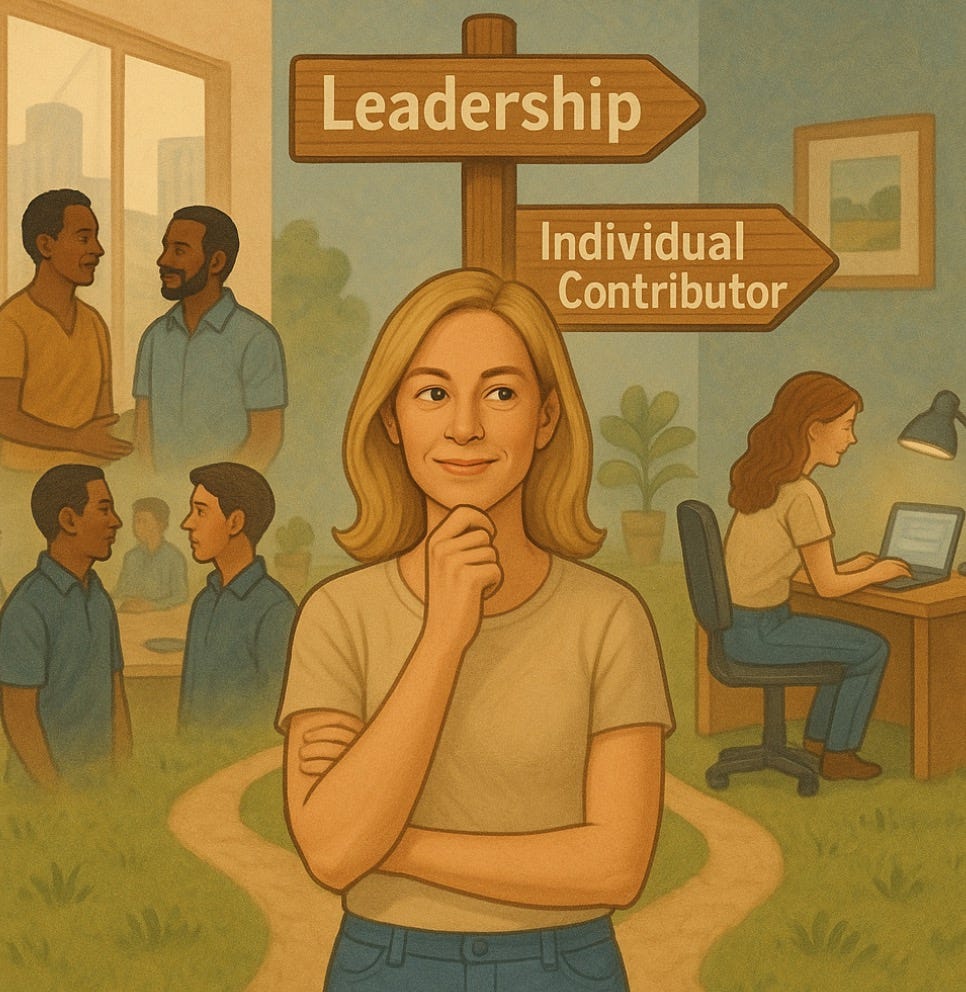Navigating the Product Management Rollercoaster: From IC to Leader
A guide for PMs embracing change while staying true to themselves
Are you a Product Manager at a crossroads - stay or go? Feeling pressure to climb the ladder but wondering if it's the right move? Or maybe you're a seasoned leader missing the hands-on nature of an individual contributor (IC) role?
You're not alone.
Recently I've been continually hearing from PMs questioning their path. One client at a tech giant confessed feeling lost as her boss constantly changed direction. Another, a long time PM lead, was weighing a move back to an IC role after a layoff.
The pressure is real. Today's job market isn't making transitions easier. In California, we're seeing 1.7 job seekers for every open position, breaking the old "career ladder". Instead I recommend embracing the "career lattice" – moving sideways, diagonally, or taking a strategic step down. This is the new norm.
But how do you navigate? How do you decide when to lead, lean back, or change direction? And most importantly, how do you stay true to yourself in the process?
Let's dive into the mental and practical strategies that can help you thrive, regardless of your product direction.
Mindset Shift from Execution ←→ Strategy
The biggest hurdle with clients is the mental shift from tactical execution to strategic thinking. It's not just about getting things done. It's about determining what should be done in the first place.
Here's a framework I use with my coaching clients:
Tactical thinking: How do we solve this problem?
Strategic thinking: Is this the right problem to solve?
Try this exercise: Take your current roadmap and ask "Why?" three times for each initiative. If you can't connect it to a meaningful business outcome by the third why, you're stuck in tactical mode.
If your company lacks a clear strategy, it's an opportunity to step up. Consider drafting a strategy yourself, using frameworks like the Strategy Stack. This proactive approach can spark valuable conversations and align your team's efforts.
Building Influence Without Losing Yourself
One of my clients, let’s call her Maya, was struggling with this challenge. As an introvert who valued authentic connections, she felt uncomfortable with the "political" maneuvering around her.
Maya's experience isn't unique. Which is truly too bad as research shows organizations encouraging authentic self-expression see 28% lower turnover rates and 16% higher engagement. Yet many still struggle to bring their authentic selves to work, especially when product development feels like a competitive sport.
There are strategies to navigate such environments authentically. Here's what worked for Maya and may work for you:
Amplify others first: Before promoting your ideas, become known for acknowledging others' contributions. Maya started by highlighting her team members' contributions in meetings, which built goodwill and established her as a collaborative leader.
Find your authentic presence: Executive presence doesn't mean becoming someone else. It means being the most confident version of yourself. When presenting to executives, Maya used data to back up her points, leveraging her analytical strengths and making an impact.
Master the "I/We" balance: "I believe this approach will help us achieve our team's goals" hits the sweet spot.
Maya increased her influence without compromising her values or changing her personality by focusing on these authentic approaches.
Skills That Actually Matter for Strategic Leadership
Beyond typical PM skills, here's what makes the difference for strategic leaders:
Cross-functional fluency: Create a Duolingo for cross-functional colleagues to communicate effectively and understand their perspectives. A product leader with this skill can bridge technical feasibility with engineers, user experience with designers, and revenue with executives.
Emotional intelligence: Learn to recognize and manage your emotional triggers. A product leader uses this skill to navigate a tense meeting about conflicting priorities, ensuring all voices feel heard and a plan is agreed.
Coaching mindset: Guide your team to find solutions instead of solving every problem yourself. When a team member struggles with stakeholder management, ask how or what questions to help them develop their own strategy instead of providing a solution.
Product sense beyond features: Understand market dynamics and business models. A product leader uses this skill to identify a new market opportunity that aligns with the company's strengths, even outside the current product line.
Remember, product sense isn’t static. It needs ongoing refinement as markets, technologies, and customer needs evolve.
Embracing AI as Your Career Accelerator
Let’s discuss what’s top of mind. AI is changing product management. The good news is AI can scale your efforts if you’re in - or returning to - an IC role where the number of tactical asks keeps increasing.
As AI reshapes product management, view it as a tool for acceleration rather than a threat. Embrace AI by developing a "learn-it-all" versus "know-it-all" mindset. How? Use an AI tool of choice and ask it to:
Analyze large user feedback data sets to identify patterns and prioritize feature requests.
Generate multiple perspectives on a product problem to consider overlooked angles.
Draft initial versions of product requirements or strategy documents for refinement and personalization.
Remember, the goal is to use AI to augment your skills, not replace your unique insights and decision-making abilities.
Your Personal ABCDE Development Plan
I've developed the ABCDE Framework to help you navigate transitions and keep growing. I've used this with dozens of product people in structuring personal growth. Most importantly, it works.
A - Audience, assess your position with colleagues, stakeholders, and leadership (skills, impact, satisfaction).
B - Behavior, brainstorm possible paths forward with diverse human and AI counterparts.
C - Content, choose your next meaningful goal and document it. Writing it down will make it tangible and easier to share.
D - Develop, draw upon the skills and relationships to build a community to scale product delivery efforts.
E - Evaluation, execute with regular reflection and adjust just as you would an experiment (hypothesis, test, iterate, rinse & repeat).
The magic happens when you personalize the ABCDE’s to your strengths. There’s no one-size-fits-all path to strategic leadership.
Balancing Ambition and Well-being
Balancing ambition with well-being is crucial, yet often overlooked. Being a successful product manager is a marathon, not a sprint. It requires authenticity, time to breathe, and a supportive culture.
I’ve burned out trying to repackage myself in leadership roles when an exec wanted someone just like them. Don’t make my mistake! Instead embrace your authentic self.
Set boundaries around your energy by retaining blocks for focus time.
Create space between intense work periods to unwind and reflect.
Practice self-compassion when you make mistakes.
Reach out to others who will listen and be honest.
Research shows that organizations encouraging authenticity see 28% lower turnover and 16% higher engagement. Employees who feel they can "be themselves" at work are three times more likely to stay with their companies.
By prioritizing both your ambition and well-being, you're promoting a more authentic, engaged, and stable work environment that benefits not just you, but everyone around you too.
Your Unique Product Journey
As we've explored transitioning between IC and leadership roles, remember your journey is unique. The strategies and frameworks we've discussed are tools, but your path will be shaped by your strengths, values, and circumstances.
There’s no perfect template for becoming a strategic leader or transitioning to a more hands-on IC role. The most impactful product people I know learned from others and wrote their own playbook.
Your journey will be shaped by your unique strengths, values, and organization's context. Embrace that uniqueness! It's not just okay to be you. Authenticity is your superpower.
I'd love to hear about your product journey. What's been your biggest challenge? Reply and let me know. I read every message.
Until next time.
P.S. If you found this helpful, share it with a product manager friend facing a career move. If you're not subscribed, join us! Here are a few other ways to connect.
Reach out over LinkedIn: Diana Stepner
Curious about coaching? Let’s talk.
Get notified about my Maven course on applying soft skills as a product manager





"I’ve burned out trying to repackage myself in leadership roles when an exec wanted someone just like them." -- This is far too common—and something I’ve experienced as well. I burned out trying to repackage myself into what a leader wanted, just to match their version of what ‘good’ looked like. The most valuable (and hardest) lesson I’ve learned is that the best way to prevent burnout is to stay true to who you are. It’s not always easy—especially when someone else’s idea of ‘fit’ feels like the only way —but in the long run, authenticity is the most strategic advantage you have.